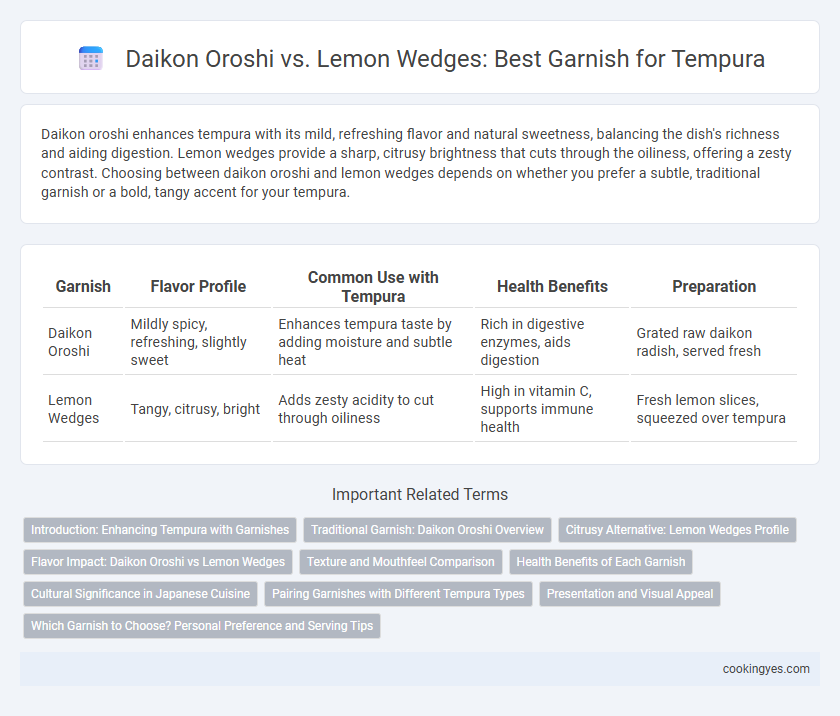Daikon oroshi enhances tempura with its mild, refreshing flavor and natural sweetness, balancing the dish's richness and aiding digestion. Lemon wedges provide a sharp, citrusy brightness that cuts through the oiliness, offering a zesty contrast. Choosing between daikon oroshi and lemon wedges depends on whether you prefer a subtle, traditional garnish or a bold, tangy accent for your tempura.
Table of Comparison
| Garnish | Flavor Profile | Common Use with Tempura | Health Benefits | Preparation |
|---|---|---|---|---|
| Daikon Oroshi | Mildly spicy, refreshing, slightly sweet | Enhances tempura taste by adding moisture and subtle heat | Rich in digestive enzymes, aids digestion | Grated raw daikon radish, served fresh |
| Lemon Wedges | Tangy, citrusy, bright | Adds zesty acidity to cut through oiliness | High in vitamin C, supports immune health | Fresh lemon slices, squeezed over tempura |
Introduction: Enhancing Tempura with Garnishes
Daikon oroshi offers a refreshing, mildly spicy flavor that cuts through the oiliness of tempura, adding a light, tangy zest while aiding digestion. Lemon wedges provide a bright, citrusy contrast that enhances the crispy texture and imparts a subtle acidity to balance the fried batter. Choosing between daikon oroshi and lemon wedges depends on the desired flavor profile, with daikon oroshi delivering a traditional Japanese palate and lemon offering a familiar Western twist.
Traditional Garnish: Daikon Oroshi Overview
Daikon oroshi, a finely grated daikon radish, serves as a traditional and essential garnish for tempura, offering a mild, slightly sweet flavor that complements the dish without overpowering it. This natural condiment enhances the tempura's light, crispy texture by adding moisture and a refreshing contrast to its savory batter. Unlike lemon wedges, which impart a sharp citrus tang, daikon oroshi maintains the authentic Japanese culinary balance, highlighting the tempura's delicate taste and preserving its cultural heritage.
Citrusy Alternative: Lemon Wedges Profile
Lemon wedges provide a bright, zesty citrus flavor that enhances the light, crispy texture of tempura without overpowering its delicate taste. Unlike daikon oroshi, which offers a mild, slightly sweet and refreshing contrast, lemon wedges introduce a sharper acidity that cuts through the oiliness, balancing the dish. This citrusy alternative is popular for adding a vibrant aroma and tangy dimension to tempura garnishes.
Flavor Impact: Daikon Oroshi vs Lemon Wedges
Daikon oroshi offers a mild, slightly sweet, and refreshing zest that enhances tempura by balancing its oiliness without overpowering the delicate batter. In contrast, lemon wedges introduce a sharp, tangy acidity that cuts through the richness, providing a bright, citrusy contrast that intensifies the overall flavor profile. Choosing daikon oroshi maintains the traditional subtlety, while lemon wedges add a vivid, invigorating twist to the tempura experience.
Texture and Mouthfeel Comparison
Daikon oroshi offers a soft, juicy texture that complements tempura by adding a refreshing, slightly grainy mouthfeel, balancing the crispiness of the batter. Lemon wedges provide a sharp, acidic burst with a smooth juice that cuts through the oiliness, enhancing the overall lightness without altering the crunchy texture. The choice between daikon oroshi and lemon wedges ultimately affects the sensory experience, with daikon contributing a mild, moist contrast and lemon delivering a bright, tangy finish.
Health Benefits of Each Garnish
Daikon oroshi offers digestive enzymes that aid in breaking down tempura's fried batter, improving nutrient absorption and supporting digestive health. Lemon wedges provide a rich source of vitamin C and antioxidants, boosting the immune system and reducing inflammation. Both garnishes contribute unique health benefits, with daikon oroshi enhancing digestive function and lemon wedges supplying essential vitamins and immune support.
Cultural Significance in Japanese Cuisine
Daikon oroshi holds deep cultural significance in Japanese cuisine as a traditional garnish for tempura, symbolizing freshness and aiding digestion with its mild, slightly spicy flavor. Lemon wedges, while enhancing the dish with a bright citrus note, reflect a more modern adaptation influenced by Western tastes and are less rooted in historical Japanese culinary practices. The use of daikon oroshi aligns with the Japanese emphasis on harmony and balance in flavor, texture, and presentation within tempura dishes.
Pairing Garnishes with Different Tempura Types
Daikon oroshi offers a mild, refreshing contrast that complements vegetable and seafood tempura by enhancing sweetness and cutting through oiliness. Lemon wedges provide a zesty acidity ideal for lighter tempura varieties like shrimp, balancing richness with a bright citrus punch. Choosing between daikon oroshi and lemon wedges depends on the tempura's flavor profile and desired taste balance.
Presentation and Visual Appeal
Daikon oroshi adds a delicate, snowy white contrast to tempura, enhancing presentation with its fine, moist texture that complements the crispy batter visually and texturally. Lemon wedges contribute vibrant yellow color and a fresh citrus element, offering an eye-catching garnish that brightens the plate's overall look. Choosing daikon oroshi emphasizes subtle elegance, while lemon wedges provide bold visual appeal and a pop of color.
Which Garnish to Choose? Personal Preference and Serving Tips
Daikon oroshi offers a mild, refreshing contrast to the rich, crispy texture of tempura, enhancing flavor balance with its subtle sweetness and moisture. Lemon wedges provide a tangy zest that cuts through the oiliness, brightening the dish with citrusy sharpness preferred by those seeking a punchier taste. Choosing between daikon oroshi and lemon wedges depends on personal preference and the desired flavor profile, with daikon oroshi serving as a traditional accompaniment and lemon wedges often favored for a modern twist.
Daikon oroshi vs lemon wedges for tempura garnish Infographic

 cookingyes.com
cookingyes.com